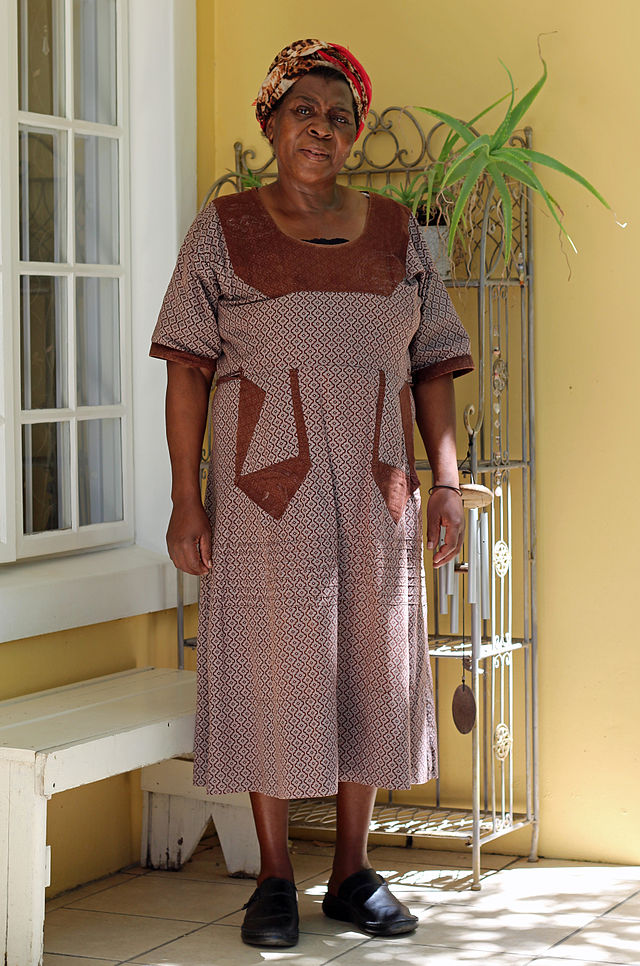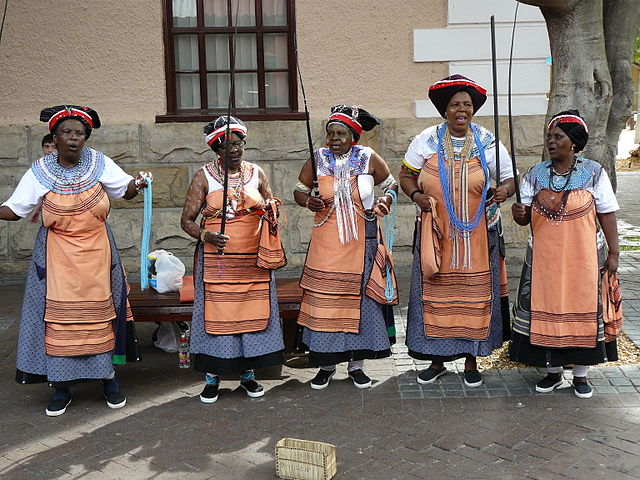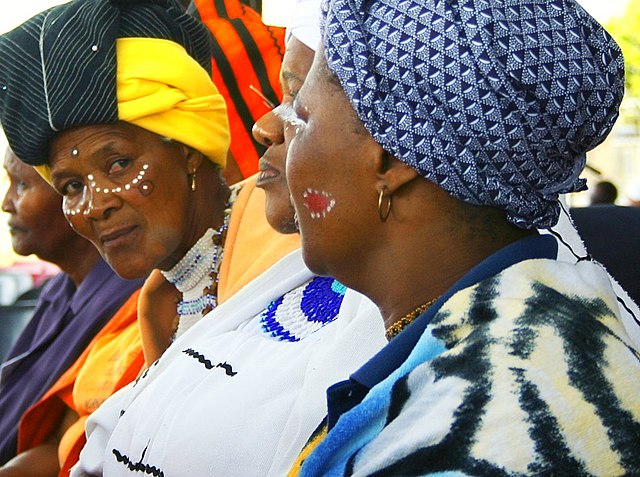舒舒(索托语:Shweshwe,IPA:/ˈʃwɛʃwɛ/[1])是一种广泛用于南部非洲传统服装的印花染色棉织物[2][3]。舒舒最初仅染成靛蓝,现可加工制成多种颜色和印花设计,以其复杂的几何图案为特色[4][5][6]。出于其受欢迎程度,舒舒被称为南非的牛仔布[6]或花呢格布[7]。

名称


舒舒的当地语言名称“Shweshwe”源自莱索托国王莫舒舒一世(“Moshoeshoe”又拼作“Moshweshwe”)与织品的关联[8][9]。莫舒舒一世在1840年代获法国传教士赠予此种织品,随后将其普及[8][10][11]。
19世纪德国和瑞士定居者进口蓝印花(Blaudruck)织品以制作其服装后,舒舒在南非与巴索托文化中的地位获进一步巩固,舒舒亦由此在塞索托语中被称作“塞杰雷马内”(Sejeremane)或“塞舒舒”(Seshoeshoe)、在科萨语中被称作“泰兰塔拉”(Terantala,源自南非语中指珠鸡的词语“Tarentaal”[10])与“乌贾马尼”(Ujamani)。[6][8][11][12][13]
用途
舒舒传统上用于制作连衣裙、短裙、围裙和围裹式服装。传统上,新婚科萨人妇女(称作“Makoti”)与已婚巴索托人妇女会穿舒舒[9][10][14][15]。科萨人妇女也将舒舒融入其传统的赭色毛毯服装中[7][16]。除传统服装外,舒舒亦为当代南非时尚设计所用,并适用于各族男女[5][9][12],且也可用于制作配饰与室内装潢[17]。舒舒在美国也被用于绗缝织品[4][18]。
生产

舒舒以在纯棉印花布上采排酸与滚筒印花技术制造[4][5][9][19]。舒舒的印刷宽度为90厘米,采通体图案与并排印刷的A字形裙板图案样式。舒舒织料可制成各种颜色,包括原始的靛蓝、巧克力棕色与红色,并有多种图案设计,包括花卉、条纹与菱形、方形、圆形等几何图案[7][11]。异光彩斑点效果(Picotage)可用于在舒舒上印刷复杂的图案。异光彩斑点效果是一种复杂与高成本而鲜为当代织料生产商所使用的针扎织料印刷技术(使用现代织料印刷技术可达到同样的设计效果)[4]。
舒舒织料现已有商标认证。舒舒织料在以前经欧洲进口到南部非洲,而自1982年以来则一直由达伽马纺织公司(Da Gama Textiles)在东开普省威廉王城外的兹韦利特沙乡生产[8][9][10][11]。1992年,达伽马收购曼彻斯特云杉制造有限公司(Spruce Manufacturing Co. Ltd)所生产的最受欢迎的三猫织料的独家经营权,并将原版雕刻铜辊运往南非[16][20]。达伽马使用从津巴布韦进口、在东开普省当地种植的棉花制作舒舒[14][18]。
包括达伽马舒舒生产线在内的南非当地纺织业受来自中国大陆与巴基斯坦进口的廉价劣质冒牌货的竞争威胁[9][11][14][21]。舒舒真品可经由手感、气味、味道、声音、染色纯度与织料反面的商标标识,小于平均90厘米的织料宽度,以及从传统淀粉洗掉的新织料的挺度予以识别[4][5][6][12]。截至2013年11月,达伽马的舒舒产量已降至每年500万米[6]。
流行文化
吉尔·史葛在电视剧《第一女子侦探社》中饰演主角姆玛·普蕾舍丝·拉莫茨韦(Mma Precious Ramotswe),并身穿由舒舒制成的服装进行拍摄。[2][22]
参见
- 非洲蜡印
参考资料
延伸阅读
外部链接
Wikiwand in your browser!
Seamless Wikipedia browsing. On steroids.
Every time you click a link to Wikipedia, Wiktionary or Wikiquote in your browser's search results, it will show the modern Wikiwand interface.
Wikiwand extension is a five stars, simple, with minimum permission required to keep your browsing private, safe and transparent.
